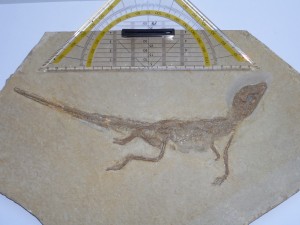I’m in Berlin. I’ve just managed to find a chicken donner kebab, and am pausing research briefly to write this. I’m currently on leave from London, with a ridiculously hectic couple of months ahead: I’ve just been to Munich to see a dwarf crocodile specimen, Alligatorellus beaumonti (from Bavaria), which conveniently happened to coincide with Oktoberfest, and am now here to visit another specimen, Theriosuchus ibericus, from Spain. Preliminary glances at the material in Berlin makes me think the Spanish material may be a new genus altogether (whatever that actually means), and another broken up specimen of Alligatorellus might be a new species, based on what I can tell from it’s body armour (yeah, these crocs were awesome!)
Why am I telling you all this? Well, firstly cos fossils are awesome, and secondly, I thought it’d be nice to continue to share what the research for my PhD actually comprises. All of these specimens are part of a poorly-known group of dwarf (<1m) crocodiles from about 160-66 million years ago called atoposaurids. These li’l fellas are quite important, as they’re probably the ancestors of the group, Neosuchia, that includes all modern crocs and more, so can tell us a lot about their early evolution – the ‘probably’ is why I’m looking at them! This is just the first leg of a trans-Europe tour, with stops in Bucharest, Barcelona, Zurich and Poitiers (France) all planned to look at more of these guys later this year.

Was also fortunate enough to see the Berlin specimen of Archaeopteryx lithographica, one of the earliest birds
In between that, there’s the Science Online conference in London (to co-run a session on the impact of open access publishing on science communication), a workshop in Bristol for 3 days to learn how to do ‘quantitative palaeontology’, for looking at biiig patterns in biodiversity through time. Oh, as well as a stop off in New York for more research, then Los Angeles for the Society of Vertebrate Palaeontology’s annual conference, where I’m presenting a poster on my Master’s research (an updated version of this, and you can find my abstract here).
So this might seem a bit showy offy, but it’s not, I hope. Let me explain – I’ve been a student for the past 7 years now (with a period of unemployment in between), and all that time, have never been able to travel due to permanently being at the bottom of my overdraft. The only way I’m able to afford this, is by staying with other friends, and having bumped off my flat in London to avoid paying rent for three months. So I’m using this as a chance to do a tonne of research and explore some new places, while continuing to work on my PhD abroad too. Fortunately, science these days is flexible enough to enable this, as you can pretty much do research from anywhere with an internet connection! (in many cases, anyway)
So I hope you’ll indulge me, for the sake of opening up what it is palaeontologists do, and I’ll try and provide pretty photos along with future posts in this little series! 🙂


Lorna Steel
Can I get some pics of Alligatorellus off you, when you come back? We have a cast, but not a very good one.
Jon Tennant
Yeah, I think that’s ok! They’ll have to be attributed to the Bavarian collections, and you’ll probs have to ask Oliver Rauhut if you’d like to use them in anything 🙂 I’ll create a shared folder on Dropbox (if you use it?) and copy them all over for you to have a peak..?
Lorna Steel
Yeah OK, I’m on Dropbox at my usual email address!